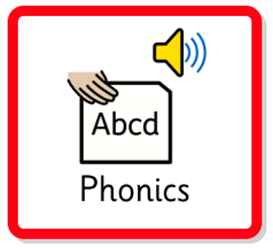Phonics

Intent
Phonics at FHIS
We follow the Government approved, systematic synthetic phonics programme: Read Write Inc for our phonics teaching. Sessions run for 40 minutes a day in small groups where children are taught to recognise sounds, read decodable green words, red tricky words and alien words. They then practise spelling these words and writing them down. Children are taught to apply their phonics skills and improve fluency through the Read Write Inc story books in used during these sessions.
Our pupils learn to read effectively and quickly using the Read Write Inc. Phonics programme.
Intent: Read Write Inc. Phonics :
The programme is for:
-
Pupils in Year R to Year 2 who are learning to read and write
In Read Write Inc. Phonics pupils:
-
Decode letter-sound correspondences quickly and effortlessly, using their phonic knowledge and skills
-
Read common exception words on sight
-
Understand what they read
-
Read aloud with fluency and expression
-
Write confidently, with a strong focus on vocabulary and grammar
-
Spell quickly and easily by segmenting the sounds in words
-
Acquire good handwriting….
And love reading!
In addition, we teach pupils to work effectively with a partner to explain and consolidate what they are learning. This provides the teacher with opportunities to assess learning and to pick up on difficulties, such as pupils’ poor articulation, or problems with blending or alphabetic code knowledge. We group pupils homogeneously, according to their progress in reading rather than their writing. This is because it is known that pupils’ progress in writing will lag behind progress in reading, especially for those whose motor skills are less well-developed.
Implementation
In EYFS we emphasise the alphabetic code. The pupils rapidly learn sounds and the letter or groups of letters they need to represent them. Simple mnemonics help them to grasp this quickly. This is especially useful for pupils at risk of making slower progress. This learning is consolidated daily. Pupils have frequent practice in reading high frequency words with irregular spellings – common exception words.
We make sure that pupils read books that are closely matched to their increasing knowledge of phonics and the common exception words. This is so that, early on, they experience success and gain confidence that they are readers. Re-reading and discussing these books with the teacher supports their increasingly fluent decoding.
Alongside this, children have access to non-fiction texts within their Read, Write Inc Phonics session to apply phonic knowledge and learning to other genres.
Embedding the alphabetic code early on means that pupils quickly learn to write simple words and sentences. We encourage them to compose each sentence aloud until they are confident to write independently. We make sure they write every day.
Pupils write at the level of their spelling knowledge. The quality of the vocabulary they use in their writing reflects the language they have heard in the books the teacher has read to them; they have also discussed what the words mean.
Our aim is for pupils to complete the phonics programme as quickly as possible. The sooner they complete it, the sooner they will be able to choose books to read at their own interest and comprehension level.
How we assess and track children’s progress:
We assess all pupils following Read Write Inc. Phonics using the Entry Assessment. We use this data to assign them to either Read Write Inc. Phonics and Read group. This gives us a very good indication of how well they are making progress relative to their starting points. We do this for all pupils, whenever they join us, so we can track all of them effectively, including those eligible for the pupil premium.
For those on the Read Write Inc. Phonics programme, we record their starting date and entry point on the tracker to monitor the rate at which they are making progress. We can also easily identify those who joined the programme later. We have high expectations of our pupils’ progress. We attribute this to the programme and to the expectations it builds in.
Pupils who are making slower progress usually complete the programme by the end of Year
2. We support pupils who have identified special educational needs for however long it takes until they can read. For example, we identify those who are at risk of falling behind their peers immediately – whatever their age. Highly trained staff tutor them for 15 minutes every day, using the Read Write Inc. One-to-one tutoring programme. If a child arrives in Key Stage 2 reading below their chronological age or with English as an additional language they are taught Read Write Inc. Phonics until they too catch up with their peers.
The programmes’ ‘cycle of instruction’ means that, after direct instruction and guided practice, the pupils teach another pupil. In this way they all rehearse and consolidate what they have been learning. This helps the pupils to make their understanding clear to themselves and helps the teacher deal with any misconceptions. ‘Partner teaching’ is a key assessment tool. We also use this approach very effectively in other subjects.
In Read Write Inc. Phonics, because the pupils are grouped across the school in terms of their reading ability, they are reading at an appropriate decoding level every day. The homogeneous groups in the Phonic lessons help us to focus the teaching and ensure pupils learn to read quickly.
Staff teaching Read Write Inc. Phonics record the results from the Assessments 1 and 2, which take place every eight weeks. This data allow us to intervene in different ways. For instance, we quickly move pupils to another group if they are progressing faster than their peers. Those who continue to struggle have one-to-one tutoring so that they keep up.



